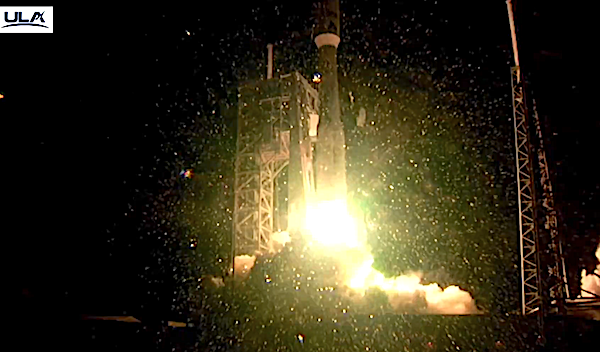
A United Launch Alliance (ULA) Atlas V rocket carrying the ViaSat-3 Flight 2 (F2) mission for Viasat, Inc., a global leader in satellite communications, lifted off on Nov. 13 at 10:04 p.m. EST from Space Launch Complex-41 at Cape Canaveral Space Force Station. This mission reflects on ULA’s goals of collaborating with customers to enable the future of global connectivity. Photo captured by Satnews.
“At ULA, we pride ourselves in delivering our customer’s spacecraft precisely to orbit and serving as the catalyst for our customers to enable global connectivity,” said Gary Wentz, ULA vice president of Government and Commercial Programs. “We partner in the shared goals of connecting the world and this successful launch aligns with this core mission. Thank you Viasat for your trust in our shared visions and successful partnership.”
The Atlas V 551 rocket launched the ViaSat-3 F2 ultra-high-capacity broadband spacecraft to a geosynchronous transfer orbit (GTO). This spacecraft is expected to add significant capacity and flexibility to Viasat’s global, multi-orbit network that supports consumer, commercial and government customers. Designed to add 1Tbps capacity to Viasat’s global network, ViaSat-3 F2 will help address the increasing demand for secure, reliable and high-bandwidth services over the Americas.
The United Launch Alliance Atlas V 551 rocket lifted off at 10:04 p.m. EST (0304 UTC) on a commercial satellite delivery mission for operator Viasat with the state-of-the-art, all-electric ViaSat-3 Flight 2 spacecraft bound for geosynchronous transfer orbit. Launch occurred from Space Launch Complex-41 at Cape Canaveral in Florida. Photo captured by Satnews.
Following the first stage of flight, the Centaur upper stage performed an initial burn that achieved a parking orbit. A second burn then inject the rocket and payload into an intermediate geosynchronous transfer orbit.
The seven-hour launch countdown started at 2:44 p.m. EST under the guidance of ULA Launch Conductor Ed Kitta. The rocket was powered up and underwent standard day-of-launch testing while crews finished configuring the launch pad. The “go” for fueling was given by ULA Launch Director James Whelan and tanking operations were successfully performed as 66,000 gallons of liquid oxygen and liquid hydrogen were placed into the rocket’s tanks. The clear to launch was given at 9:58 p.m. EST.
UPDATE: It’s a GO! as ULA progresses towards Thursday launch of ViaSat-3 F2 mission
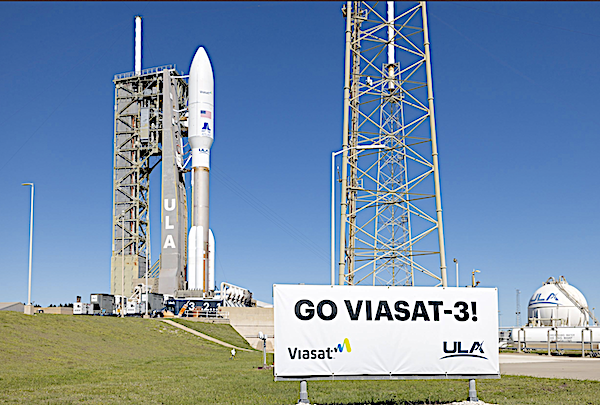
Satnews received an announcement just hours ago that after the challenges of getting ViaSat-3 F2 mission aloft it looks like today’s the day. The last internal announcement was on November 6, so fingers crossed that patience during the delays has paid off.
Everything is progressing towards the ULA Atlas V launch carrying the ViaSat-3 Flight 2 (F2) mission for Viasat, a global technologies company. The mission is planned to lift off on Thursday, November 13, from Space Launch Complex-41 at Cape Canaveral Space Force Station in Florida. The launch is planned for 10:04 p.m. EST with a 44-minute window.
Live updates
L-5 hours
All systems remain “go” here at the Advanced Spaceflight Operations Center and at the launch pad as we count down to tonight’s Atlas V launch at 10:04 p.m. EST (0304 UTC). The weather is favorable and we are working no issues.
At Space Launch Complex-41, the Atlas V rocket has undergone its flight control steering check of the engine nozzle gimbaling, and soon the flame bucket cover has been retracted and stowed for launch.
Currently underway is a pre-launch test of the rocket’s S-band telemetry relay system and the GPS Metric Tracking system used to follow the rocket as it flies downrange.
Weather GO for launch
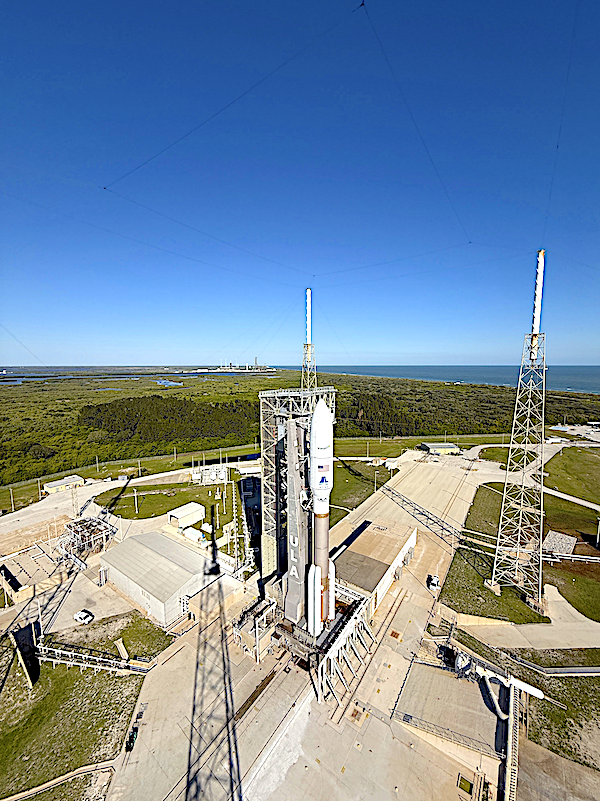
Both launch weather and space weather are GO, according to the day’s first weather briefing by Space Force Launch Weather Officer Brian Cizak from the Space Launch Delta 45 weather squadron at Cape Canaveral.
A strong surface high pressure system has built up over the Florida peninsula, leading to weaker winds and not a cloud in the sky. That gives us very favorable launch weather conditions tonight.
Solar activity has been a hot topic this week with X-ray flares and elevated proton flux. But the situation has gradually calmed over the past day and the Atlas V criteria for launch is GO and expected to remain that way through the window tonight.
The operations forecast for the 44-minute launch window that opens at 10:04 p.m. EST (0304 UTC) includes clear skies, good visibility, northerly winds 7 to 11 knots and a temperature near 63 degrees F.
Nov 13 12:32
The Atlas and Centaur stages have been powered to begin launch day testing and final preparations for fueling operations. Also underway at this hour are the first stage propulsion, pneumatic and hydraulic preps, as well as final preps for the Centaur liquid oxygen and liquid hydrogen systems.
All is going smoothly in the countdown for liftoff in just over six-and-a-half hours.
Atlas V countdown begins!
United Launch Alliance has initiated the countdown for tonight’s launch of the Atlas V rocket on a commercial satellite deployment mission with the ViaSat-3 Flight 2 spacecraft.
ViaSat-3 F2 is an ultra-high-capacity broadband satellite, designed to be capable of transmitting throughput in excess of one Terabit of data per second (1 Tbps) to users on land, at sea or in the air. ULA is performing the launch for Viasat, a global technology company helping businesses, governments and communities transform their world through connectivity.
We have a GO status at this time and activities are on schedule for liftoff to occur at 10:04 p.m. EST (0304 UTC) from Space Launch Complex-41 at Cape Canaveral Space Force Station in Florida. The available launch window remains open until 10:48 p.m., a duration of 44 minutes.
The launch countdown is a tightly scripted sequence of procedures and steps over the next seven hours that will complete pre-launch testing, fill the rocket with propellants and put systems into flight mode. The count started at exactly 2:44 p.m. EST (1944 UTC) from the T-minus 6 hours, 20 minutes point, with two pre-planned built-in holds scheduled tonight. One 30-minute pause is reserved prior to fueling at T-minus 2 hours, the other 30-minute hold occurs prior to the terminal count at T-minus 4 minutes.
The application of power to the Atlas and Centaur stages is underway at the start of today’s countdown procedures. The stages are being powered up to begin launch day testing and final preparations for fueling operations.
Over the next few hours, final preps for the liquid oxygen and liquid hydrogen systems will be performed, along with first stage propulsion and hydraulic preps, a test of the rocket’s guidance system, internal battery checks and testing of the GPS Metric Tracking system used to follow the rocket as it flies downrange, plus a test of the S-band telemetry relay system.
Our live, play-by-play updates from Atlas Launch Control will begin at 7:00 p.m. EST (0000 UTC) as we prepare for loading cryogenic propellants into the rocket.
UPDATE: ULA’s ViaSat-3 F2 mission ready to try again on Thursday after replacing valve

The launch of a United Launch Alliance Atlas V carrying the ViaSat-3 F2 mission for Viasat is now planned for no earlier than Thursday, November 13, 2025.
To ensure compliance with the recent FAA order regarding launch times, the launch is scheduled for 10:04 p.m. EST at the opening of a 44-minute window, from Space Launch Complex-41 at Cape Canaveral Space Force Station, Florida.
The United Launch Alliance Atlas V rocket is back atop Space Launch Complex-41 and poised for liftoff Thursday night to deliver the commercial ViaSat-3 F2 ultra-high-capacity broadband satellite into space.
The mobile launch platform was secured at Space Launch Complex-41 at 1:30 p.m. EST (1830 UTC) today.
Thursday’s liftoff is planned for 10:04 p.m. EST (0304 UTC) at the opening of a 44-minute launch window. The weather forecast is 95 percent favorable.
ULA will provide countdown status in our live blog beginning at 7 p.m. EST (0000 UTC) and our launch webcast begins at L-20 minutes.
Following the scrub last week due to a faulty booster liquid oxygen tank vent valve, the team at the Cape removed and replaced it with a new valve in preparation for this launch attempt.
UPDATE: Scrubbed for ULA’s launch of ViaSat-3 F2 mission due to technical difficulties
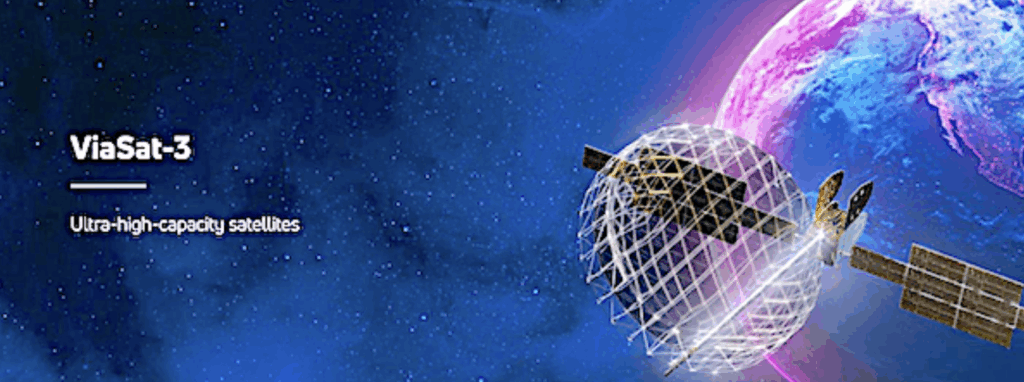
The launch of a United Launch Alliance Atlas V carrying the ViaSat-3 F2 mission for Viasat is scrubbed for tonight’s launch attempt due to an issue encountered while cycling the booster liquid oxygen tank vent valve during final checkouts. The team will require additional time for troubleshooting and is setting up for a 24-hour recycle. The launch will be from Space Launch Complex-41 at Cape Canaveral Space Force Station in Florida.
The team will require additional time for troubleshooting and is setting up for a 24-hour recycle.
The launch is now planned for Thurs., Nov. 6 at 10:16 p.m. EST at the opening of a 44-minute window.
UPDATE: GO! as ULA preps for V ViaSat-3 Flight 2 launch tomorrow from the Cape
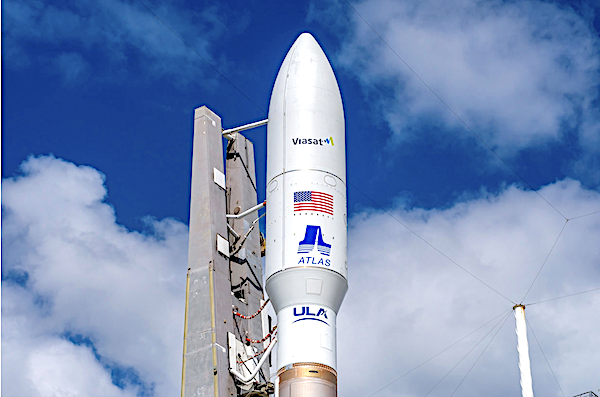
Everything continues to progress towards the ULA Atlas V launch carrying the ViaSat-3 Flight 2 (F2) mission for Viasat, a global technologies company. The mission is planned to lift off on Wednesday, November 5, from Space Launch Complex-41 at Cape Canaveral Space Force Station in Florida. The launch is planned for 10:24 p.m. EST with a 44-minute window. Today’s forecast shows a 95 percent chance of favorable weather conditions for launch.
Atlas V’s first stage has been filled with room-temperature RP-1 propellant that will feed the main engine during the initial phase of tomorrow night’s Viasat-3 Flight 2 launch. Loading of cryogenic liquid hydrogen and liquid oxygen occurs in the final hours of the launch countdown.
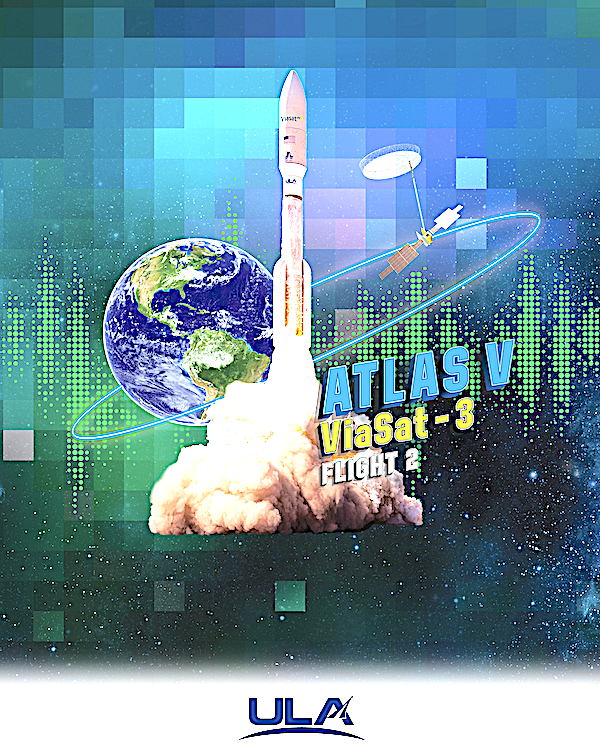
According to weather officials, there’s a 95% chance of favorable weather conditions at the time of the launch. Officials are monitoring weather conditions with concerns related to Cumulus Cloud Rule. The forecast calls for a temperature of 74°F, overcast clouds, 95% cloud cover and a wind speed of 5mph.
Viasat’s message on X: L-1 day until launch! With 5 solid rocket boosters & 2.7 million lbs of thrust ULA’s 196-ft tall Atlas V 551 rocket made its way to SLC-41 at Cape Canaveral for final checks before tomorrow’s #ViaSat3F2 launch. Tune in tomorrow at 10:03 p.m. EST: http://vsat.co/vs3
Launch Forecast Summary:
- Overall probability of violating weather constraints: 5%
- Primary concerns: Cumulus Cloud Rule
- 24 hour back up: overall probability of violating weather constraints: 10%
- Primary concerns: Cumulus Cloud Rule
UPDATE: ULA’s Launch Readiness is GO! for Wednesday ViaSat-3 Flight 2 one of the most powerful commercial communication satellites
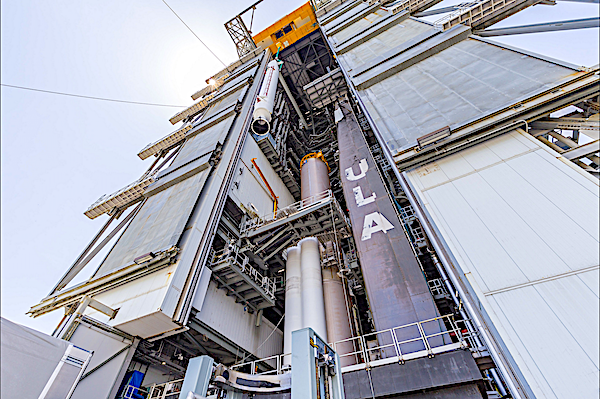
The solid rocket boosters (SRBs) are mounted onto the United Launch Alliance (ULA) Atlas V rocket that will launch the ViaSat-3 F2 ultra-high-capacity broadband satellite. Photo credit: United Launch Alliance
Everything continues to progress towards the ULA Atlas V launch carrying the ViaSat-3 Flight 2 (F2) mission for Viasat, a global technologies company. The mission is planned to lift off on Wednesday, Nov. 5, from Space Launch Complex-41 at Cape Canaveral Space Force Station in Florida. The launch is planned for 10:24 p.m. EST with a 44-minute window. Today’s forecast shows a 95 percent chance of favorable weather conditions for launch.
An Atlas V 551 rocket, configured with five side-mounted solid rocket boosters and a standard-length payload fairing, will utilize several launch optimization features to place the ViaSat-3 Flight 2 spacecraft into a geosynchronous transfer orbit. The craft is one of the heaviest single-satellite payloads. Liftoff will occur from Space Launch Complex-41 at Cape Canaveral Space Force Station, Florida.
Launch Readiness Review completed The Launch Readiness Review (LRR) is GO for Wednesday’s liftoff of the United Launch Alliance commercial Atlas V rocket with one of the most sophisticated and powerful commercial communications satellites — the ViaSat-3 Flight 2 ultra-high-capacity broadband spacecraft.
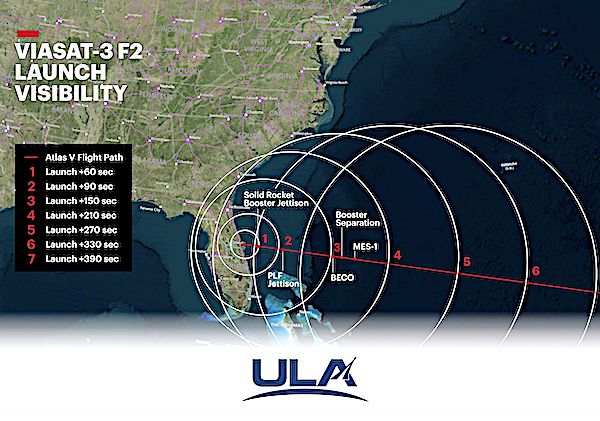
The LRR, led by ULA Launch Director James Whelan, was completed this morning at the Advanced Spaceflight Operations Center (ASOC).
Leadership from ULA, Viasat and Space Force assessed the readiness of the rocket, payload, mission assets and tracking support, discussed the status of pre-flight processing work, heard technical overviews of the countdown and flight, and previewed the weather forecast that projects a 95 percent chance of meeting the launch rules.
At the conclusion of the meeting, senior leaders were polled and gave a ready status for launch, then signed the Launch Readiness Certificate.
The Atlas V rocket, designated AV-100, stands 196 feet (59.7 meters) tall and will launch the payload into an elliptical geosynchronous transfer orbit (GTO). At liftoff, the rocket generates a combined thrust of 2.7 million pounds (12 megaNewtons) from its main engine and five solid rocket boosters.
ULA will offer live reports from launch control in our automatically refreshing blog beginning Wednesday at 7:30 p.m. EST (0030 UTC). The launch webcast starts at L-20 minutes.
The forecast calls for a temperature of 80°F, overcast clouds, 100% cloud cover and a wind speed of 7mph.
Launch Forecast Summary:
- Overall probability of violating weather constraints: 5%
- Primary concerns: Cumulus Cloud Rule
- 24 hour back up: overall probability of violating weather constraints: 10%
- Primary concerns: Cumulus Cloud Rule
ULA’s Atlas V plans ViaSat-3 F2 launch November 3
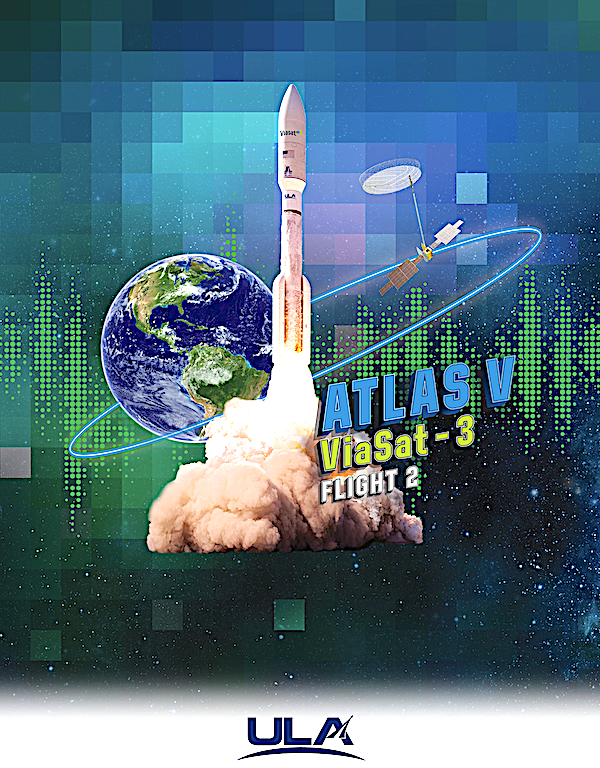
The launch of a United Launch Alliance (ULA) Atlas V 551 rocket carrying the ViaSat-3 Flight 2 (F2) mission for Viasat is planned for no earlier than Monday, November 3, 2025, pending range approval.
Once in service, VS-3 F2 is expected to more than double the bandwidth capacity of Viasat’s entire existing fleet and marks a significant milestone in our satellite roadmap.

An Atlas V 551 rocket, configured with five side-mounted solid rocket boosters and a standard-length payload fairing, will utilize several launch optimization features to place the ViaSat-3 Flight 2 spacecraft into a geosynchronous transfer orbit. The craft is one of the heaviest single-satellite payloads. Liftoff will occur from Space Launch Complex-41 at Cape Canaveral Space Force Station, Florida.
The launch is scheduled for 10:36 p.m. EST at the opening of a 44-minute window, from Space Launch Complex-41 at Cape Canaveral Space Force Station, Florida.

ULA’s Atlas V ready to launch VIASAT-3 Flight 2 enhancing global connectivity

ULA’s Atlas V will soon be launching the ViaSat-3 Flight 2 ultra-high-capacity broadband spacecraft that is the second of three ultra-high-capacity satellites for Viasat, a global technology company.
Designed to significantly increase their global internet bandwidth capacity ViaSat is helping businesses, governments and communities transform their world through connectivity. Once in service, ViaSat-3 Flight 2 is expected to more than double the bandwidth capacity of Viasat’s entire existing satellite fleet and deliver enhanced global connectivity.
The ViaSat-3 is scheduled to launch in the second half of October from Cape Canaveral Space Force Station, Florida, aboard a United Launch Alliance (ULA) Atlas V rocket.
Boeing built ViaSat-3 arrives at Cape Canaveral for upcoming launch

Viasat’s ultra-high-capacity ViaSat-3 Flight 2 (VS-3 F2) satellite, built by Boeing, has completed its cross-country flight from Los Angeles International Airport (LAX) to Kennedy Space Center, Florida.
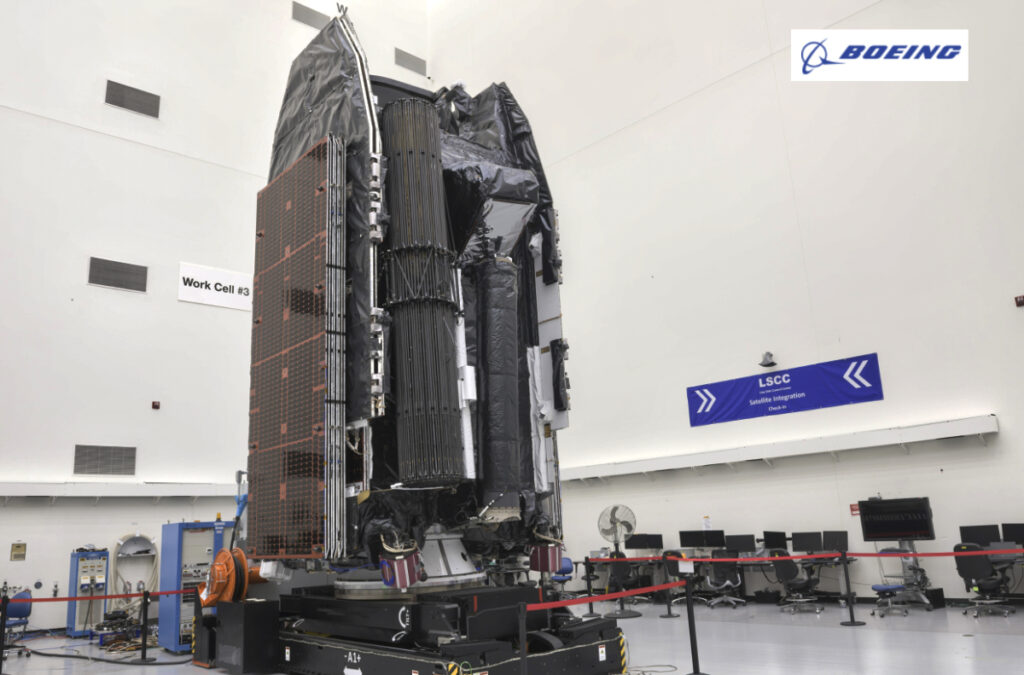
VS-3 F2 was delivered to LAX by Boeing from its El Segundo, California, facility, before being transported in one of the world’s largest cargo airplanes, an Antonov AN-124, touching down in Florida in the early hours of September 30, 2025.
The satellite was safely and securely shipped in a specialized container that carefully controls environmental factors such as temperature and air cleanliness as required to protect the highly complex technology throughout the flight.
With precision down to the millimeter, loading the container onto an AN-124 cargo bay is an exceptionally intricate procedure that takes around four to six hours.
Now that VS-3 F2 has arrived at Cape Canaveral Space Force Station, the Boeing and Viasat teams, together with launch partner United Launch Alliance (ULA), are readying the spacecraft for launch in late October 2025, aboard a powerful ULA Atlas V 551 rocket.
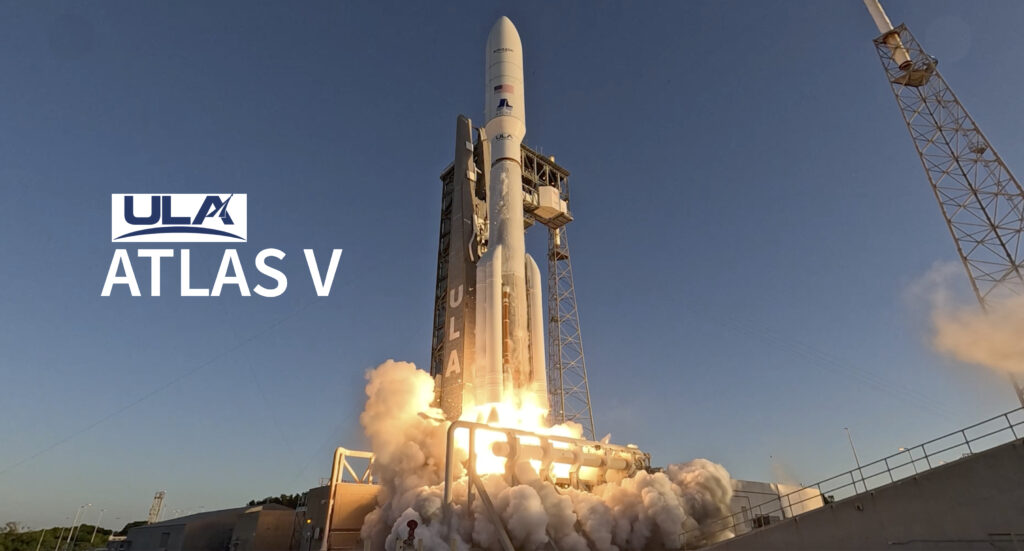
VS-3 F2 is the second of three ViaSat-3 Ka-band satellites and is designed to provide more than double the bandwidth capacity of Viasat’s entire existing fleet. Upon anticipated service entry in early 2026, VS-3 F2 is expected to add more than 1 Tbps capacity to our network over the Americas.
VS-3 F2 will now undergo comprehensive testing to verify all systems are go for launch following transport. After this, the satellite will be secured to the Atlas V launch vehicle adapter, enclosed within the payload fairing, which protects it during the three minutes of atmospheric flight, and then mated (attached) to the rocket. From there, it will be put through final preparations ahead of launching VS-3 F2 into a GTO, from which the satellite will propel itself over the coming few months into GEO approximately 22,000 miles (36,000 km) above the Earth’s equator.
The Atlas V rocket, which stands 196 feet (59.7 meters) tall and will weigh 1.3 million pounds (587,000 kg) when fully fueled at liftoff, will be rolled out to Space Launch Complex 41 (SLC-41) at Cape Canaveral Space Force Station the day before launch.
I’m extremely proud of the Viasat team and our partnership with Boeing in successfully completing ViaSat-3 F2’s manufacture and testing. Being just a few weeks out from launch is incredibly exciting – this achievement represents the dedication and innovative spirit of hundreds of talented professionals who’ve lent their expertise to this mission. A huge thank you to everyone who has contributed to this milestone. Now we turn our focus to getting F2 into orbit, where its tailored capabilities are expected to enable us to better serve our customers and meet increasing demand for resilient, global satellite communications,” said Dave Abrahamian, Vice President of Space Systems, Viasat. “The VS-3 constellation represents an important part of our global, multi-orbit, multi-band network, adding capacity that is secure, reliable, and highly flexible: with dynamic-beam-forming capabilities designed to rapidly shift capacity to wherever demand is greatest.”
